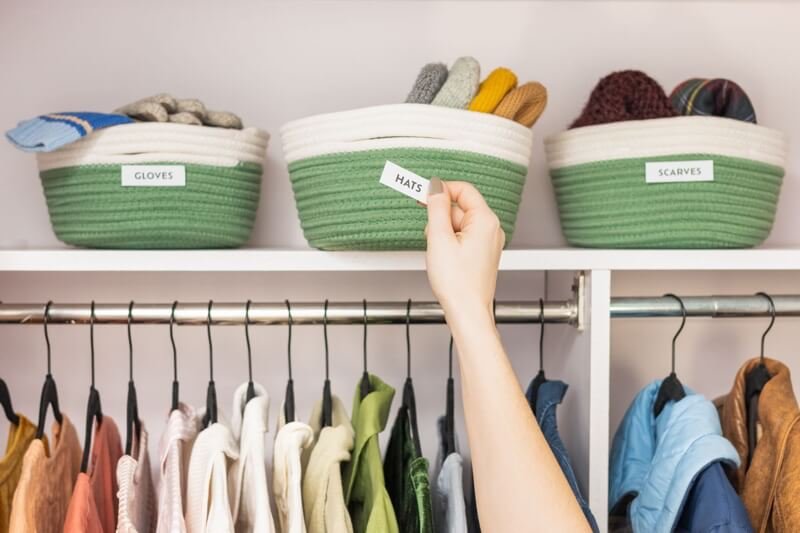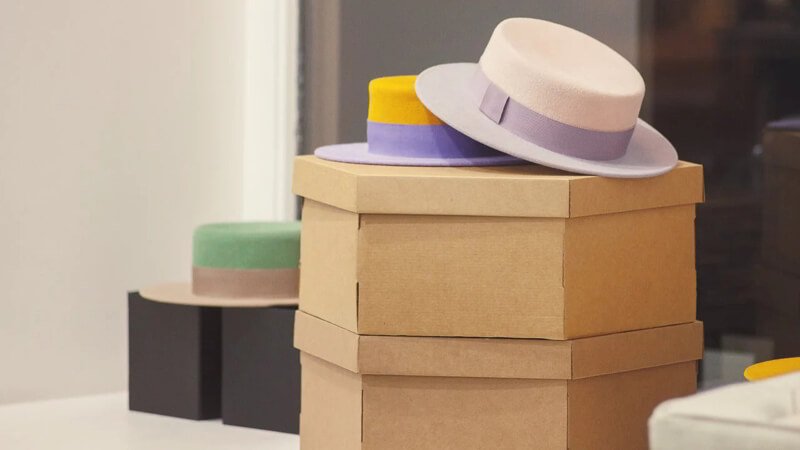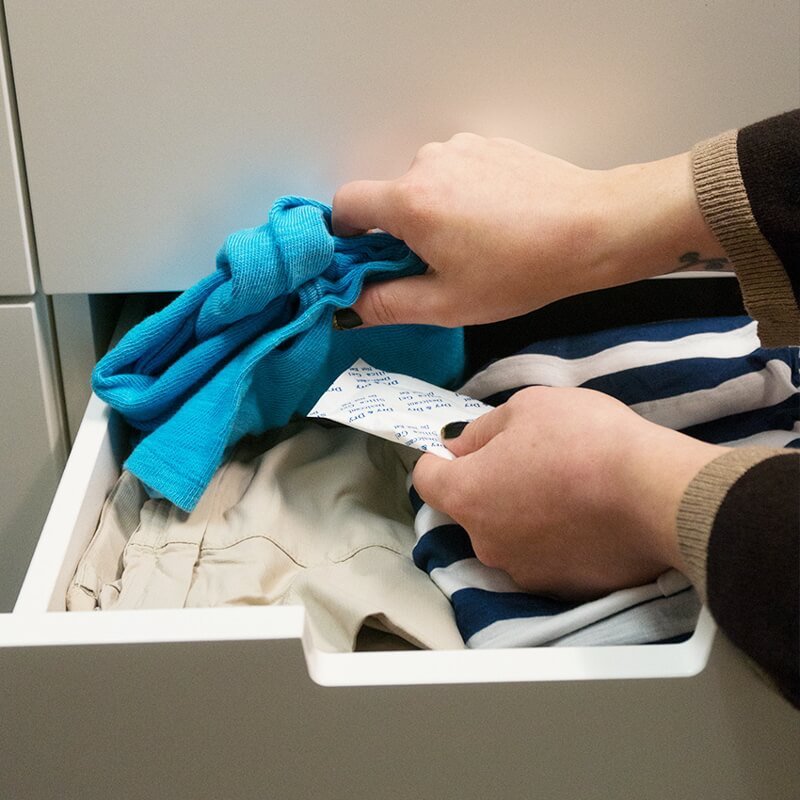The Ultimate Guide to Storing Clothes: Expert Tips and Tricks
Cluttered closets, difficulty finding clothes, and the fear of damaging garments during storage – these are common frustrations. Whether you’re preparing for a seasonal change, moving, or simply seeking a more organized wardrobe, proper clothes storage is essential. It’s not just about tidiness; it’s about protecting your clothing investment. Improper storage wastes money (damaged clothes), time (searching for items), and increases stress.
This comprehensive guide provides a system for storing clothes effectively. You’ll learn to declutter, clean, choose the right containers, use optimal folding/hanging techniques, and protect against pests and damage. Gain the knowledge to create an organized, efficient wardrobe, saving time, money, and stress. Extend the life of your clothing and enjoy a more functional living space.
1. Why proper clothes storage matters?
Proper clothes storage is more than just neatness; it’s about preserving clothing quality, maximizing space, and creating an organized wardrobe. Think of your clothes as an investment – proper storage protects that investment, extending the lifespan of your garments and keeping them looking their best. A well-organized system also makes getting dressed easier and less stressful, streamlining your daily routine and saving you valuable time.

2. Step 1: Prepare your clothes for storage
This crucial first step sets the stage for successful, long-term storage.
2.1 Declutter and organize
Before storing anything, declutter your wardrobe. The 80/20 rule is a good starting point: we often wear only 20% of our clothes 80% of the time. A helpful technique is the hanger trick:
- Turn all the hangers in your closet backward.
- After wearing an item, return it to the closet with the hanger facing the correct way.
- After a set period (e.g., six months or a year), honestly assess the clothes still on backward-facing hangers. These are likely items you rarely or never wear.
Options for unwanted clothes:
- Donate: Give gently used items to charity organizations.
- Sell: Sell clothes online (e.g., Poshmark, ThredUp, eBay) or at consignment shops.
- Recycle: Look for textile recycling programs in your area. Many clothing retailers now offer take-back programs.
- Repurpose: Transform old clothes into cleaning rags, tote bags, or other useful items.
- Discard: As a last resort, discard items that are too worn or damaged to be reused.
Be ruthless! If you haven’t worn something in a year (excluding special occasion items), chances are you won’t miss it. Decluttering frees up space and makes it easier to see and access the clothes you actually love and wear.
2.2 Clean and repair
Never store dirty clothes! Even seemingly clean garments can harbor sweat, body oils, and food residue. These attract pests (like moths and silverfish) and can cause stains to set permanently over time.
- Wash or dry clean all items before storing them, following the care instructions on the labels.
- For washable fabrics, use a gentle, non-biological detergent, especially for delicate items like cashmere and wool.
- Repair any minor damage: Sew on missing buttons, fix broken zippers, mend small tears or fallen hems. Addressing these small issues now prevents them from becoming bigger problems later.
2.3 Prepare your storage area
Before putting your clean and repaired clothes away, take a moment to clean the storage space itself.
- Dust shelves and drawers.
- Vacuum closet floors and under-bed storage areas.
- Wipe down surfaces with a gentle cleaning solution.
- Consider using a linen spray for a refreshing scent
A clean storage environment helps keep your clothes fresh and protected.

3. Step 2: Choose the right storage solutions
Selecting the right containers and methods is crucial for protecting your clothes during storage.
3.1 Container selection guide
Different types of containers are suited for different types of clothing and storage situations. Here’s a breakdown:
| Container Type | Pros | Cons | Best For |
|---|---|---|---|
| Plastic Bins | Durable, stackable, moisture-resistant, protect against pests, relatively inexpensive. Clear bins allow visibility. Dark bins protect against light. | Not breathable, can trap moisture if clothes aren’t completely dry. | Non-delicate items, long-term storage, areas with potential moisture or pests (but ensure clothes are completely dry). |
| Cardboard Boxes | Inexpensive, readily available, recyclable. | Not moisture-resistant, susceptible to pests, not very durable, can collapse under weight. | Short-term storage (indoors only), items that are not delicate or susceptible to pests. Not recommended for long-term storage or valuable items. |
| Fabric/Canvas Bins | Breathable, aesthetically pleasing, often come with lids, good for closet shelves. | Less durable than plastic, offer less protection against moisture and pests. | Folded items, in-closet storage, items that need to breathe (e.g., sweaters). |
| Garment Bags | Protect clothes from dust, allow hanging, ideal for preserving the shape of structured garments. Breathable fabric bags are essential for long-term storage. | Plastic dry cleaner bags trap moisture and should never be used for long-term storage. | Suits, dresses, coats, formal wear, delicate fabrics, items that should be hung. |
| Vacuum-Sealed Bags | Excellent for saving space by compressing bulky items. | Not suitable for natural fibers (wool, cashmere, silk, down), as compression can damage the fibers and prevent them from breathing. | Bulky synthetic items (e.g., ski jackets, comforters), seasonal bedding. |
| Under-Bed Storage | Space-saving, convenient. | Prone to dust accumulation, potentially limited airflow. | Folded clothes. |
Avoid open-top containers: Open-top containers allow dust to accumulate on clothes and offer less protection from pests.
For long-term storage, choose containers that protect against moisture, pests, and light. Plastic bins are generally a good choice, provided the clothes are completely dry and the bins are not airtight if you’re storing natural fibers. Breathable fabric garment bags are essential for hanging delicate items.
3.2 Folding and hanging techniques
How you store your clothes directly impacts their condition. Improper folding or hanging can lead to wrinkles, stretching, and damage.
- Rolling: Rolling clothes is a space-saving technique that also minimizes wrinkles. It’s particularly effective for travel and for storing clothes in bins or drawers. Roll items tightly but not so tightly that you create creases.
- Folding delicate items: Gently fold delicate items like cashmere sweaters and heavy knits. Avoid sharp creases. You can place acid-free tissue paper between layers to further protect against creasing and snagging.
- Folding knits: Knitwear, especially heavy sweaters, should always be folded flat. Hanging can stretch and distort the shape of knit garments.
- Folding denim: To prevent hard creases, fold jeans by laying them flat, folding one leg over the other, then folding the pair in half or thirds.
- Vertical filing (shirts): Many organizing experts recommend folding shirts and storing them vertically in drawers, like files in a filing cabinet. This method saves space, makes it easy to see each item, and prevents the bottom shirts in a stack from being crushed.
- Hanging: Hanging is the best way to store items that wrinkle easily, such as blouses, dresses, suits, and coats. It also helps maintain the shape of structured garments.
- Hanger types: Opt for sturdy wooden hangers to support and maintain the shape of heavier items like coats and suits, while padded or flocked (velvet) hangers are ideal for delicate fabrics, as their gentle, non-slip surfaces prevent both creasing and slippage. It’s best to avoid flimsy wire hangers entirely, as they can permanently stretch, distort, and damage your clothing over time.
3.3 Label everything
Clearly label all storage containers with their contents. This seemingly small step will save you significant time and frustration when you need to retrieve items later. Be specific (e.g., “Winter Sweaters – Wool & Cashmere,” “Summer Dresses – Silk & Linen”). Label multiple sides of the container for easy visibility, regardless of how it’s stacked or stored.

4. Step 3: Storing specific clothing items
Different garments require different storage approaches.
4.1 Delicate and valuable items
- Suits and gowns: Hang suits and gowns on sturdy wooden or padded hangers. Cover them with breathable fabric garment bags to protect them from dust and light. Avoid plastic dry cleaner bags for long-term storage.
- Silk items: Delicate silk blouses, dresses, and scarves should be hung on padded hangers or carefully folded with acid-free tissue paper to prevent creasing.
- Knitwear: Fold sweaters and other knitwear flat to prevent stretching. Store them in drawers, shelves, or breathable fabric bins.
- Lingerie (bras): Do not fold bras with molded cups, as this can damage their shape. Store them flat or stacked in a drawer, ensuring they are not compressed by other items.
4.2 Accessories
- Hats: Store hats in hat boxes or on shelves, ensuring they are not crushed. Stuff hat crowns with acid-free tissue paper to help them maintain their shape.
- Gloves and scarves: Fold or roll gloves and scarves and store them in drawers, boxes, or hanging organizers.
- Shoes and boots: Clean and polish shoes and boots before storing. Use shoe puffs (for shoes) and boot trees (for boots) to help them maintain their shape. Store them in breathable fabric shoe bags or boxes to protect them from dust.
- Wrap smaller accessories in acid-free tissue paper and place them in breathable fabric shoe boxes with moth-repelling sachets

5. Step 4: Choose the ideal storage location
5.1 The ideal environment
The best storage environment for clothes is cool, dark, and dry.
- Cool: Heat can damage fibers, cause colors to fade, and accelerate the degradation of fabrics.
- Dark: Sunlight can fade colors and weaken fabrics, especially natural fibers.
- Dry: Moisture is the enemy of stored clothing. It can lead to mold, mildew, and a musty odor.
5.2 Location options and considerations
| Location | Pros | Cons |
|---|---|---|
| Closet | This location is convenient, accessible, and generally has a stable environment if the home is climate-controlled. | Space can be limited and may require decluttering to maximize storage. |
| Under-Bed | This is a space-saving option that utilizes otherwise unused space. | This area can be prone to dust accumulation and may have limited airflow. |
| Guest Room Closet | This provides extra space if available and is often less frequently used than main closets. | It may not be accessible year-round and may require transporting clothes back and forth. |
| Shelves | These are good for folded items, allowing for easy visibility and access. | Items can be exposed to dust and light, which may require more frequent cleaning. |
| Attic | This area offers large storage capacity if it is finished and accessible. | It often experiences extreme temperature fluctuations, has potential for pests and moisture, and can be difficult to access. |
| Basement | This location can be spacious and maintain a cool temperature. | There is a potential for moisture, dampness, risk of flooding, and pests. |
| Storage Unit | Climate-controlled units offer ideal storage conditions and are secure. | This option comes with an added cost and requires transporting items to and from the unit. |
| Garage | This location offers a large amount of storage space. | It often experiences extreme heat and temperature swings that can damage fabrics. |
Avoid storing clothes in areas with extreme temperature changes or high humidity. Attics and garages can be problematic unless they’re climate-controlled. Basements can be damp, so use moisture absorbers and ensure good ventilation. The ideal long-term storage environment is one that is comfortable for you – if you wouldn’t be comfortable spending a few hours there, your clothes probably won’t be either!
If you must use less-than-ideal spaces (attics, basements, garages), place containers towards the front for easier access and monitoring, and use extra protection (moisture absorbers, pest repellents).
6. Step 5: Protecting against pests and damage
6.1 Keep out pests
Moths: Moths are a major threat to natural fibers like wool, cashmere, and silk.
- Cedar: Use cedar blocks, chips, or sachets. Cedar has a natural scent that repels moths. Refresh cedar regularly (sanding lightly or adding cedar oil) to maintain its effectiveness.
- Lavender: Lavender sachets are another pleasant-smelling alternative to mothballs.
- Pheromone traps: These traps attract and trap adult moths, helping to prevent them from laying eggs.
Silverfish: These pests are attracted to starches, adhesives, and paper. Keep storage areas clean and dry.
6.2 Prevent damage
- Ensure clothes are 100% dry before packing them away. Even slight dampness can lead to mold and mildew growth.
- Use moisture absorbers in storage containers, especially in potentially damp environments (basements, storage units). Silica gel packets or commercial moisture absorbers are effective.
- Sunlight can cause clothes to fade, so store them in a dark place or use opaque containers.
- For particularly delicate items, wrap them in acid-free tissue paper before storing. This provides an extra layer of protection against dust, snagging, and creasing.

7. Step 6: Long-term storage and seasonal rotation
7.1 The seasonal swap
The most efficient way to manage your wardrobe is to rotate your clothes seasonally.
- Prepare the outgoing season’s clothes: Follow the steps outlined earlier: declutter, organize, clean, and repair.
- Store the outgoing season’s clothes: Pack them carefully in appropriate containers, using the techniques described above.
- Unpack the incoming season’s clothes: As you unpack, inspect each item for any signs of damage or wear. Clean or repair as needed.
- Prepare the incoming season’s clothes: follow the steps for storage preparation. This cyclical process keeps your closet organized and ensures your clothes are well-maintained.
7.2 Long-term maintenance
Even for clothes in long-term storage, ongoing care is essential.
- Air out clothes at least once a year: This helps prevent musty odors and allows you to inspect for any signs of pests or damage.
- Refresh moth repellents: Replace or refresh cedar blocks/chips and lavender sachets annually.
- Replace moisture absorbers: Replace silica gel packets or other moisture absorbers as needed, based on the humidity of the storage environment.
- Creating an inventory of your stored items is a good idea, especially if you have a lot of clothing in long-term storage. This makes it easier to track what you have and locate items when needed.
8. FAQs about best way to store clothes
8.1 What’s the best way to store clothes to save space?
Vacuum-sealed bags are excellent for saving space with bulky synthetic items (like ski jackets or comforters). However, avoid using them for natural fibers (wool, cashmere, silk, down), as the compression can damage the fibers and prevent them from breathing.
Rolling clothes instead of folding them is another great space-saver, especially for travel and for storing clothes in bins or drawers. Vertical filing of folded shirts maximizes drawer space and allows you to see each item at a glance.
8.2 How do I prevent my clothes from getting musty in storage?
The key to preventing musty odors is to ensure your clothes are completely dry before storing them and to store them in a cool, dry place. Use moisture absorbers (silica gel packets or commercial products) in your storage containers, especially in humid environments. Airing out stored clothes periodically also helps.
8.3 Is it better to fold or hang sweaters?
It’s generally better to fold sweaters, especially heavy knits, to prevent them from stretching and losing their shape. Hanging can cause the shoulders to become distorted and can create permanent hanger marks.
8.4 Can I store clothes in plastic dry cleaner bags?
No, it’s not recommended to store clothes in plastic dry cleaner bags long-term. These bags are designed for temporary protection during transport, not for storage. They trap moisture, which can lead to mildew, yellowing, and damage to the fabric. Use breathable fabric garment bags instead for hanging items.
8.5 How do I store clothes long-term?
- Thoroughly clean all items before storing, following care label instructions.
- Repair any damage (missing buttons, tears, etc.)
- Choose the right containers for storage location
- Use moth protection, cedar, or lavender.
- Fold or hang clothes appropriately.
- Store in a cool, dark, and dry place.
- Air out clothes annually and refresh moth repellents/moisture absorbers.
- Consider an inventory for easy location.
Read more:
Proper clothes storage is an investment in the longevity and appearance of your wardrobe. By decluttering regularly, cleaning clothes before storing them, choosing the right storage containers and location, implementing techniques to protect against pests and damage, and maintaining a regular storage routine (seasonal rotation and long-term maintenance), you can create a more organized, accessible, and stress-free wardrobe. You’ll extend the life of your clothes, save time and money, and enjoy the benefits of a well-managed closet. Start organizing your wardrobe today and experience the difference!
While Packlove specializes in custom labels, tags, zipper bags, and poly mailers for clothing, we understand the importance of proper garment care and storage. With over 8 years of experience in the garment industry, particularly in processing labels and tags, we can offer advice and resources. Visit our website Packlove to explore our services and contact us for any inquiries.






















